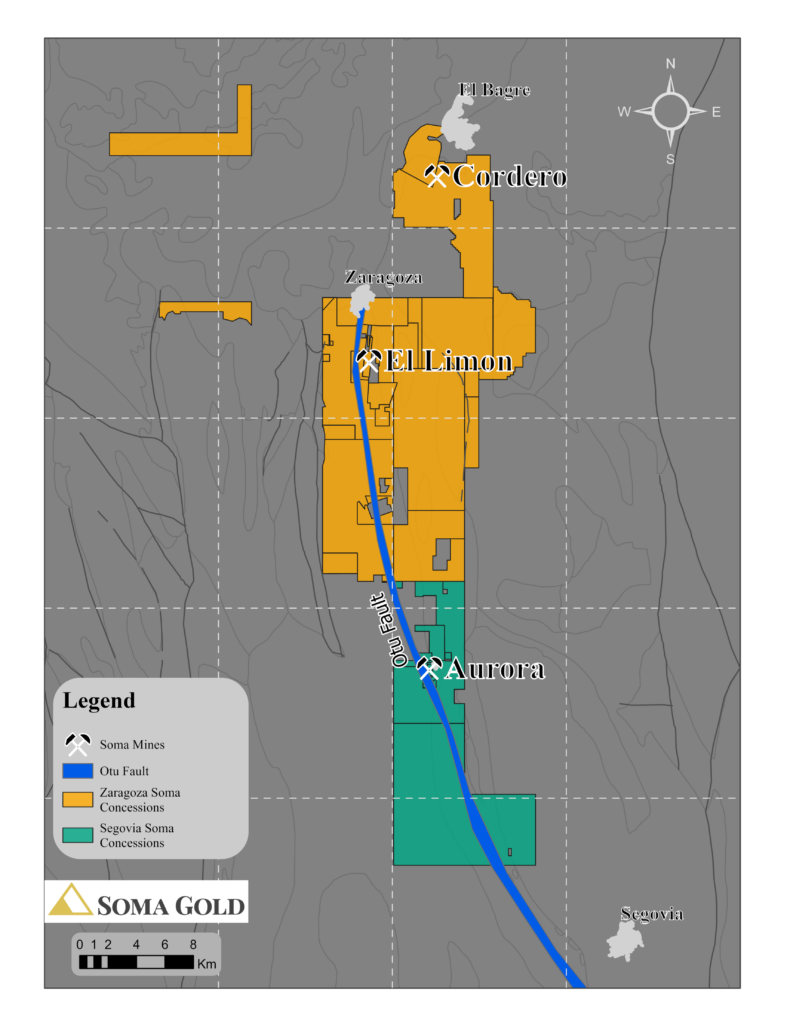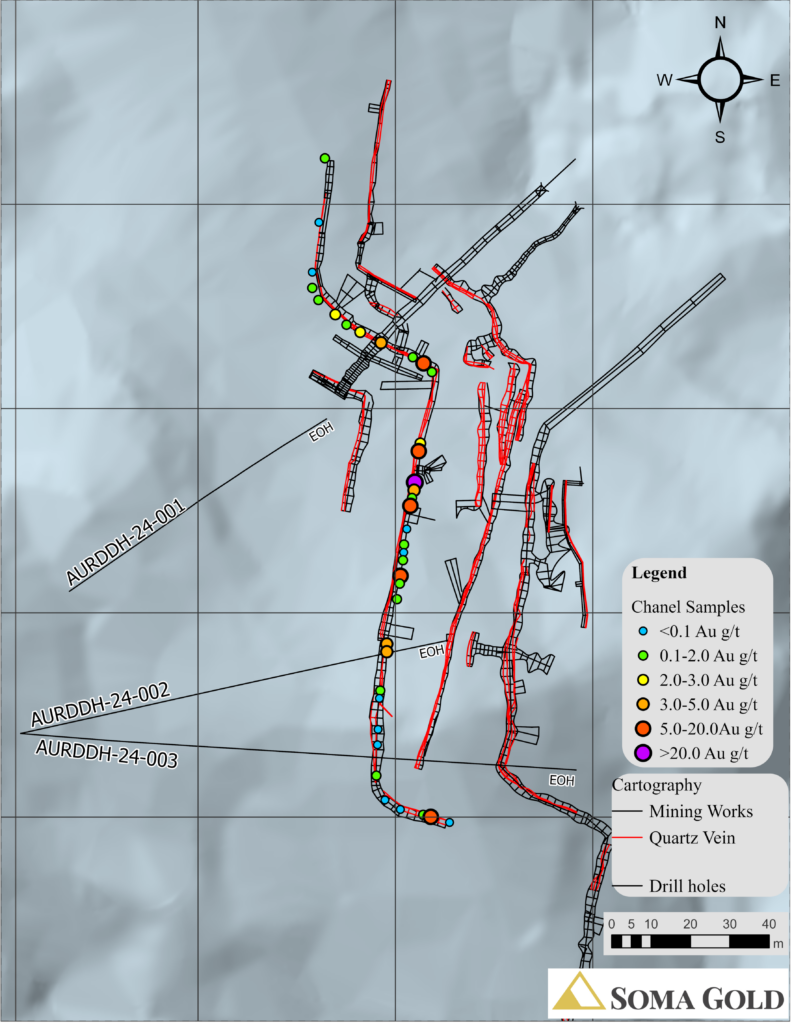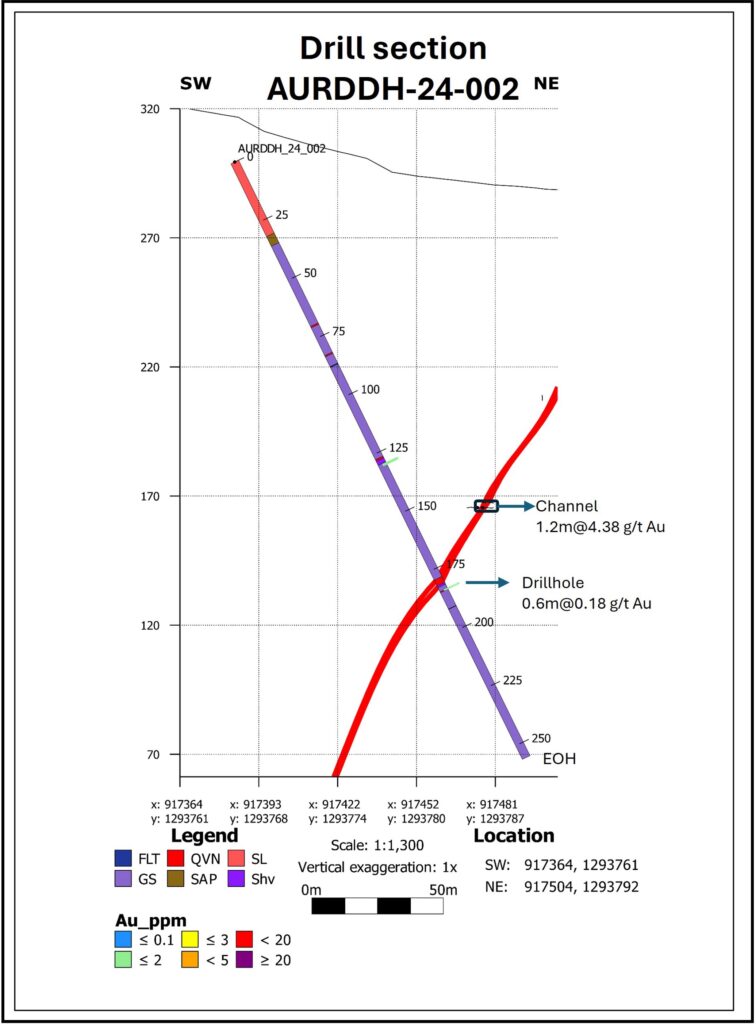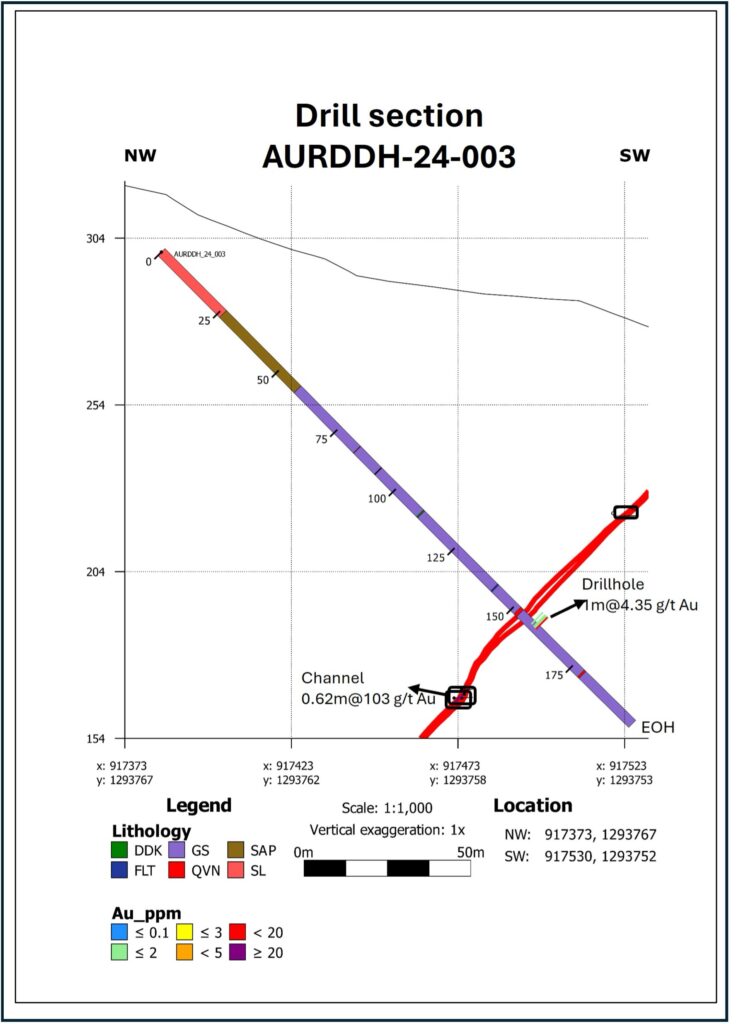March 5, 2024, Vancouver, British Columbia – Soma Gold Corp. (TSXV: SOMA) (WKN: A2P4DU) (OTC: SMAGF) (the “Company” or “Soma”) is pleased to announce the results of the initial diamond drill program conducted at the La Aurora Mine on the Machuca Project in central Colombia (Figure 1). Three drill holes, totalling 656m of drilling, were successfully completed in late December 2023. Furthermore, this release also presents the results obtained from the 2022 due diligence underground sampling program. The assays from both the channel samples and drill holes are detailed and discussed herein.
Highlights include the following drill intercept:
AURDDH-24-003 1.0m at 4.35 g/t Au incl. 0.5m at 8.35 g/t Au
Composited underground channel sampling highlights include:
AURORA5_GS_AR8_ABS_10S 0.65m at 36.64 g/t Au incl. 0.25m at 94.7 g/t Au
AURORA5_GS_AR8_ABS_2S 0.8m at 14.17 g/t Au incl. 0.3m at 37.77 g/t Au
AURORA5_GS_AR8_ABS_16S 0.9m at 11.03 g/t Au incl. 0.4m at 9.92 g/t Au
La Aurora Mine is located on the western side of the Otu Fault within an area characterized by a regionally extensive high-metaphoric grade gneiss. Quartz veins in this region form as laminated fault-fill veins within a sinistral brittle-ductile shear zone, interpreted as a higher-order structure associated with the Otu Fault. The controlling fault zone is predominantly north-south striking and dips moderately to steeply to the west.
This fault, along with associated quartz veins, forms a series of en echelon segments that consistently step approximately 25m-50m to the left along strike. Uniquely oriented quartz veins, created to accommodate extension within step-over zones, in these domains strike southeast and dip steeply to the south. Extensional step-over zones are recognized as hosting high-grade ore shoots and represent highly promising exploration targets.
In 2022, Soma conducted due diligence channel sampling at La Aurora Mine. The channel samples were collected along the strike of La Constancia vein on level 5 of the mine. A total of 69 channel samples were obtained from 37 lines covering approximately 110m along the strike of La Constancia vein. Out of these, 35 samples were quartz vein material from La Constancia vein, while the remaining 34 samples were wall rock shoulder samples in the footwall and hanging wall of the quartz vein. Table 1 presents the composite grades of each channel sample line, ranging from 0.01 g/t Au to 94.67 g/t. Among these, 21 quartz vein samples reported gold grades exceeding 0.4 g/t, with the remaining 15 vein samples indicating the nuggety nature of the gold distribution. Notably, seven wall rock shoulder samples returned gold assays ranging from 0.9 g/t Au to 9.07 g/t Au, attributed to thin veins containing sulphides and gold in the footwall of the main vein structure. The grade distribution of the due diligence samples aligns with the historical underground channel sample dataset, where the maximum historical sample along La Constancia vein was 146 g/t Au. Due diligence samples adjacent to the high-grade historical sample reported gold assays exceeding 7 g/t.

In late December 2023, a drill program was initiated to enhance confidence in the down-dip continuity of the vein structures observed in historical mine workings. The primary objective was to test the interpreted high-grade ore shoots and investigate whether the La Constancia quartz vein extends below level 5 of the historical mine (Figure 2). Table 2 provides the composite assays from the drill holes, and each hole is briefly discussed below.
AURDDH-23-001 unexpectedly intersected mine workings not documented in existing mine surveys. It could not be completed to the planned depth and, consequently, prevented the hole from intersecting the targeted section of the Constancia vein.
AURDDH-24-002 (Figure 3) Targeting down dip of high-grade channel samples from La Constancia vein on level 5, this hole intersected the vein 30 m below level 5, spanning from 178.8 m to 181.35 m with an approximate true width of 2.25 m true width (Figure 3). The milky white quartz vein was brecciated by younger, brittle fractures during structure reactivation. The fractures are filled with crushed vein material and pyrite. Assay samples of the vein did not return any significant gold values. A narrow interval of thin quartz veins occurs 2.5 m downhole from the main vein intersection and returned a weakly anomalous gold value of 0.18 g/t Au over 0.35 m at a depth of 183.9 m.
AURDDH-24-003 (Figure 4) was designed to intersect a southeast striking, steeply dipping quartz vein segment that forms in the extensional stepover zone between the Constancia and Aurora veins. The vein, interpreted as forming in a normal fault accommodating extension between the two north-south striking veins, was intersected from 151.6 m to 152.7 m with a true width of 1.0 m, situated 30 m up-dip of its exposure on level 5. The intersection is comprised of a late milky white quartz-carbonate vein crosscutting an older brecciated dark grey quartz vein. In the footwall, 1 cm to 3 cm thick quartz veins with variable orientations and density form a 35m wide stockwork interval. The veins contain 1%-5% sphalerite and galena, which typically accompanies gold mineralization along the Otú Fault corridor. The quartz-carbonate vein was barren of gold mineralization, but a set of thin (1.0 cm to 4.0 cm) quartz veins with pyrite, sphalerite, and galena returned a gold assay of 8.35 g/t over 0.5 m within the stockwork interval. Additional sampling has been undertaken to continuously sample the entire stockwork interval to determine whether any unsampled quartz veins also contain high-grade gold.
Soma’s Vice President of Exploration, Chris Buchanan, stated, “We are pleased that the first phase of drilling intersected quartz veins where they were predicted from initial structural models of the vein system. We’re particularly encouraged that numerous stockwork-style veins with sulphides and high-grade gold intersected in the footwall of the primary vein structure. This zone is interpreted to be an extensional step-over and has the potential to develop into a broad, high-grade ore shoot.”
The initial 2023 drill program successfully confirmed the presence of the Constancia and Aurora veins at depth below the current mine workings. While the low gold grades from the Constancia vein in AURDDH-23-002 are disappointing, they are consistent with the nuggety distribution of gold grade observed in the 2022 due diligence channel samples on level 5. Further drilling on a tighter spacing is required to fully delineate the vein and gold distribution within the vein system in La Aurora Mine.
Soma is currently engaged in dewatering the mine to its deepest levels, enabling access to Levels 1 and 5. The engineering team is diligently evaluating the safety conditions of the mine. Simultaneously, the exploration team is set to conduct geological mapping, systematic sampling, and accurate surveys of the mine workings. The resulting additional information will be seamlessly integrated into the current datasets to strategically plan the next phase of drilling in 2024.

In addition to ongoing exploration activities at La Aurora Mine, Soma’s exploration team is actively assessing various small-scale mines near Machuca. Three extensive soil grids are scheduled for 2024 to determine the continuity of gold mineralization between the informal mines along the Otú Fault. Soma also continues to work with the local communities on the Machuca Property as part of its ongoing ESG program.
Drill Core Samples
Soma Gold follows a comprehensive QA/QC program to ensure the reliability of assay data collected from its exploration programs. All samples are sawn, or split, in half, with one half being returned to the core box for storage. The second half-core is placed in a labelled plastic bag with a tag, document, and sealed for shipment. Batches of samples are shipped to ALS Colombian (ALS) in Medellin with security tags and documented chain of custody.
Pulps of each sample are prepared in Medellin and shipped to ALS Lima for analysis. All samples are analyzed using the package ME-MS41, an ICP-MS analysis that provides the concentration of 51 elements. Fifty-gram aliquots of each sample are analyzed for gold using a standard fire assay with an atomic absorption finish. Overlimit samples are subjected to an additional fire assay with a gravimetric finish to determine the gold concentration.
A comprehensive QA/QC program has been implemented to monitor the reliability of assay data collected during exploration programs. The program includes the regular insertion of certified blanks, duplicates, and certified OREAS standards. Assays of the QA/QC samples are automatically compared to the certified values and standard deviations in the database.
Channel Samples
Channel samples in Colombia are common in underground mining and are commonly used for grade control. The channel samples are marked by a spray-painted line. Individual samples along the channel are broken out based on changes in lithology (e.g. quartz vein vs wall rock). A large plastic sheet is laid out below the sample line, and the sample is chipped with a hammer and chisel. The chips are collected by the underlying plastic sheet and transferred to a sample bag.
Prior to December 2023, all the samples were analyzed by the Operadora mine laboratory and selected samples were submitted to ALS Laboratory for QA/QC analysis. The samples were crushed, split, and pulverized by the Operadora Mine laboratory. Fifty-gram aliquots of each sample is analyzed for gold using standard fire-assay with a gravimetric finish.
Since 2023 all exploration samples for Soma Gold are submitted to ALS Lima for analysis, as per the drill core procedures. This is due to renovations of the Operadora mine laboratory for improved health and safety and capacity for increased mine production. Grade control channel samples for the Cordero Mine continue to be processed at the Operadora mine laboratory.
Qualified Person Statement
Mr. Chris Buchanan, P.Geo, is Soma’s Vice-President of Exploration and a Qualified Person as defined by National Instrument 43-101. Mr. Buchanan has reviewed the technical information disclosed in this press release.
ABOUT SOMA GOLD
Soma Gold Corp. (TSXV: SOMA) is a mining company focused on gold production and exploration. The Company owns two adjacent mining properties in Antioquia, Colombia, with a combined milling capacity of 675 tpd. (Permitted for 1,400 tpd). The El Bagre Mill is currently operating and producing. Internally generated funds are being used to finance a regional exploration program.
With a strong commitment to sustainability and community engagement, Soma Gold Corp. is dedicated to achieving excellence in all aspects of its operations.
The Company also owns an exploration property near Tucuma, Para State, Brazil that is currently under option to Ero Copper Corp.
On behalf of the Board of Directors
“C. Geoffrey Hampson”
Chief Executive Officer and Chairman of the Board
For further information, please contact Andrea Laird, telephone: +1-604-259-0302
Neither the TSX Venture Exchange nor its Regulation Services Provider (as that term is defined in the policies of the TSX Venture Exchange) accepts responsibility for the adequacy or accuracy of this release.
All statements, analysis and other information contained in this press release about anticipated future events or results constitute forward-looking statements. Forward-looking statements are often, but not always, identified by the use of words such as “seek”, “anticipate”, “believe”, “plan”, “estimate”, “expect” and “intend” and statements that an event or result “may”, “will”, “should”, “could” or “might” occur or be achieved and other similar expressions. Forward-looking statements are subject to business and economic risks and uncertainties and other factors that could cause actual results of operations to differ materially from those contained in the forward-looking statements. Forward-looking statements are based on estimates and opinions of management at the date the statements are made. The Company does not undertake any obligation to update forward-looking statements even if circumstances or management’s estimates or opinions should change except as required by applicable laws. Investors should not place undue reliance on forward-looking statements.

Figure 2: 2023 Drill hole locations and 2022 channel sample locations

Figure 3: Cross-section of AURDDH-23-002




